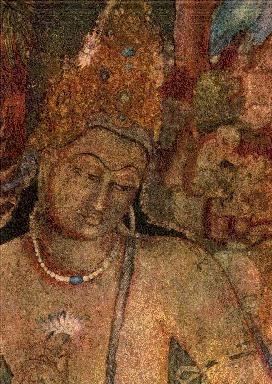Contribute
| South Asian Art - In Memory Of Prashant H. Fadia |
Art of Ajanta and Ellora
01/23/2008
The Ajanta Ellora caves in Aurangabad, India are a unique specimen of work where extremely skilled artists worked collaboratively with not just their peers but continued the unfinished work of those that went before them. A project that seems to have been a work in progress for nearly 800 years it lies as a testament to the timelessness of art.
These caves are perhaps one of the most visited sites in India. Be it the paintings of Ajanta which despite their age are still are quite a treat for the eyes, or the sculptures of Ellora one cannot but be awed by the magnificence of the artistic endeavor.
These caves are in the State of Maharashtra, India. They are about 112 km from Aurangabad a town that is situated Northeast of Mumbai. There are two series of temples carved out of living rock (rock formations still in progress) over the course of several centuries
The 34 caves at Ellora and the 29 caves at Ajanta were remained shrouded in obscurity for over a millennium, till John Smith, a British Army Officer, accidentally stumbled upon them while on a hunting expedition in 1819. Ajanta has been designated as a World Heritage Site, to be preserved as an artistic legacy that will come to inspire and enrich the lives of generations to come.
It was only in the 19th century, that the Ajanta group of caves, lying deep within the Sahyadri hills, cut into the curved mountain side, above the Waghora River was discovered. They depict the story of Buddhism, spanning a period from 200 BC to 650 AD.
The 29 caves were built as secluded retreats of the Buddhist monks, who taught and performed rituals in the Chaityas and Viharas, the ancient seats of learning, and nerve - centers of the Buddhist cultural movement. Using simple tools like hammer and chisel, the monks carved out the impressive figures adorning the walls of these structures. Many of the caves house panels depicting stories from the Jatakas, a rich mine of tales of the several incarnations of the Buddha. Images of nymphs and princesses amongst others are also elaborately portrayed.
Why did the monks choose this out of the way location to commission these magnificent works of art? Perhaps the secluded nature of the area assured the monks of the safety and continuity of their art gallery. But the caves were not far off from the ancient trade routes and pilgrims. It is clear that the visitors from all over the world have influenced the art at Ajanta.
The Buddhist Monks employed artists who turned stone walls into picture books of Buddha's life & teachings. These artists have portrayed the costumes, ornaments & styles of the court life of their times. The artists applied mud plaster in two coats - the first was rough to fill in the pores of the rocks & then a final coat of lime plaster over it. The painting was done in stages. They drew the outline in red ochre, then applied the colors & renewed the contours in brown, deep red or black. The attenuated poses, supple limbs, artistic features, a great variety of hair styles, all kinds of ornaments & jewelry indicate skilled artisans. Crushed colored rock was used as paint the brilliance of which has not dimmed much despite the ravages of weather.
In a mural in Cave 10, some 50 elephants are painted in different poses bringing out the skill of the artist in handling these bulky forms in all perspective views, with erected tails & raised trunks, depicting sensed danger.
The styles of the later murals reveal a merging of two streams of art, Satavahana of Andhra & Gupta art of North India. This resulted in the classical style which had a far reaching influence on all the paintings of the country for centuries to come.
A high degree of craftsmanship incorporating all the rules that were laid down by ancient Indian treatises on painting & aesthetics are evident. One cannot but notice the fluid, yet firm lines, long sweeping brush strokes, outlining graceful contours, subtle gradation of the same color, highlighting nose, eyelids, lips & chin making the figures emerge from the flat wall surface. Animals, birds, trees, flowers, architecture are pictured with an eye to their beauty of form. Human emotions & character are depicted with great understanding & skill - indignation, greed, love & compassion.
In our next article we will describe Ellora and the religious themes that run through the caves.
You may also access this article through our web-site http://www.lokvani.com/
